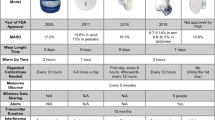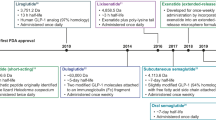Abstract
Purpose
To characterize the kinetic dependence of pulmonary absorption and metabolism of insulin and lispro on the magnitude of their hexameric association.
Methods
Hexamer content by weight percent (%Hex) in various insulin-zinc and lispro-zinc solutions were determined by quantitative centrifugal ultrafiltration and zinc titration with terpyridine (QCUF-ZTT). Each of the solutions (0.1 ml) was then administered into the airways of the IPRL of normal and experimental diabetic animals. Rate constants were determined for lung absorption (k a) and non-absorptive loss (k nal; comprising mucociliary clearance and metabolism).
Results
%Hex in administered solutions ranged from 3.3 to 94.4%. Data analysis showed excellent correlations between the values for k a or k nal and %Hex, irrespective of insulin type, concentration, solution pH or ionic strength. The values for k a decreased (0.22 → 0.05 h−1) with increasing %Hex, as did values for k nal. At %Hex in administered solutions ≥50%, values for k nal approached estimates for the rate constant for mucociliary clearance, implying that lung metabolism occurred primarily with monomeric insulin. There were no differences in insulin disposition kinetics between lungs taken from experimental diabetic and sham-control animals.
Conclusions
The kinetics of pulmonary insulin disposition depended on the magnitude of molecular self-association. Dissociated forms of insulin (dimers or monomers) in the dosing solution showed higher rates than hexamers for both lung absorption and metabolism.






Similar content being viewed by others
Abbreviations
- BSA:
-
bovine serum albumin
- CBS:
-
citrate-buffered saline
- CD:
-
circular dichroism
- COD:
-
coefficient of determination
- ELISA:
-
enzyme-linked immunosorbent assay
- %Hex:
-
percent of hexamers by weight
- IPRL:
-
isolated perfused rat lung
- IU:
-
International Unit
- LLF:
-
lung lining fluid
- MSC:
-
model selection criterion
- NIH:
-
National Institute of Health
- PBS:
-
phosphate-buffered saline
- QCUF–ZTT:
-
quantitative centrifugal ultrafiltration and zinc titration with terpyridine
- %RSD:
-
percent of relative standard deviation
- SD:
-
standard deviation
- SE:
-
standard error
- STZ:
-
streptozotocin
- t 1/2 :
-
apparent half-life
- USP:
-
United States Pharmacopeia
- UV:
-
ultraviolet
- VCU:
-
Virginia Commonwealth University
- μ :
-
ionic strength
- [θ]:
-
mean residue molar ellipticity
References
J. Brange. Galenics of insulin, Springer, Berlin, 1987.
M. R. DeFelippis, R. E. Chance, and B. H. Frank. Insulin self-association and the relationship to pharmacokinetics and pharmacodynamics. Crit. Rev. Ther. Drug Carr. Syst. 18:201–264 (2001).
S. Kang, J. Brange, A. Burch, A. Volund, and D. R. Owens. Subcutaneous insulin absorption explained by insulin’s physicochemical properties. Diabetes Care 14:942–948 (1991).
D. T. Birnbaum, M. A. Kilcomons, M. R. DeFelippis, and J. M. Beals. Assembly and dissociation of human insulin and LysB28ProB29-insulin hexamers: a comparison study. Pharm. Res. 14:25–36 (1997).
Z. Vajo and W. C. Duckworth. Genetically engineered insulin analogs: diabetes in the new millennium. Pharmacol. Rev. 52:1–9 (2000).
S. J. Farr and G. Taylor. Insulin inhalation: its potential as a nonparenteral method of administration. In A. L. Adjei and P. K. Gupta (eds.), Inhalation Delivery of Therapeutic Peptides and Proteins, Marcel Dekker, New York, 1997, pp. 371–387.
J. S. Patton, J. G. Bukar, and M. A. Eldon. Clinical pharmacokinetics and pharmacodynamics of inhaled insulin. Clin. Pharmacokinet. 43:781–801 (2004).
K. Rave, S. Bott, L. Heinemann, S. Sha, R. H. Becker, S. A. Willavize, and T. Heise. Time-action profile of inhaled insulin in comparison with subcutaneously injected insulin lispro and regular human insulin. Diabetes Care 28:1077–1082 (2005).
I. Gonda, R. M. Rubsamen, and S. J. Farr. Method of use of monomeric insulin as a means for improving the reproducibility of inhaled insulin. United States Patent, US 6250298 (Jun 26, 2001).
Y. Pang, M. Sakagami, and P. R. Byron. The pharmacokinetics of pulmonary insulin in the in vitro isolated perfused rat lung: implications of metabolism and regional deposition. Eur. J. Pharm. Sci. 25:369–378 (2005).
R. A. Roth. Flow dependence of norepinephrine extraction by isolated perfused rat lungs. Am. J. Physiol. 242:H844–H848 (1982).
B. Rodrigues, P. Poucheret, M. L. Battell, and J. H. McNeill. Streptozotocin-induced diabetes: induction, mechanism(s), and dose dependency. In J. H. McNeill (ed.), Experimental Models of Diabetes, CRC Press, Florida, 2000, pp. 3–17.
S. Rahuel-Clermont, C. A. French, N. C. Kaarsholm, M. F. Dunn, and C. I. Chou. Mechanisms of stabilization of the insulin hexamer through allosteric ligand interactions. Biochemistry 36:5837–5845 (1997).
R. H. Holyer, C. D. Hubbard, S. F. A. Kettle, and R. G. Wilkins. The kinetics of replacement reactions of complexes of the transition metals with 2,2′,2″-terpyridine. Inorg. Chem. 5:622–625 (1966).
V. Chandrashekar, R. W. Steger, A. Bartke, C. T. Fadden, and S. G. Kienast. Influence of diabetes on the gonadotropin response to the negative feedback effect of testosterone and hypothalamic neurotransmitter turnover in adult male rats. Neuroendocrinology 54:30–35 (1991).
P. R. Byron and R. W. Niven. A novel method for drug administration to the airways of the isolated perfused rat lung. J. Pharm. Sci. 77:693–695 (1988).
J. Z. Sun, P. R. Byron, and F. Rypacek. Solute absorption from the airways of the isolated rat lung. V. Charge effects on the absorption of copolymers of N(2-hydroxyethyl)-DL-aspartamide with DL-aspartic acid or dimethylaminopropyl-DL-aspartamide. Pharm. Res. 16:1104–1108 (1999).
M. Sakagami, P. R. Byron, J. Venitz, and F. Rypacek. Solute disposition in the rat lung in vivo and in vitro: determining regional absorption kinetics in the presence of mucociliary escalator. J. Pharm. Sci. 91:594–694 (2001).
D. N. Brems, L. A. Alter, M. J. Beckage,R. E. Chance, R. D. DiMarchi, L. K. Green, H. B. Long, A. H. Pekar, J. E. Shields, and B. H. Frank. Altering the association properties of insulin by amino acid replacement. Protein Eng. 5:527–533 (1992).
G. D. Fasman. Circular dichroism and the conformational analysis of biomolecules, Plenum, New York, 1996.
Y. Pocker and S. B. Biswas. Conformational dynamics of insulin in solution. Circular dichroic studies. Biochemistry 19:5043–5049 (1980).
K. Hinds, J. J. Koh, L. Jones, F. Liu, M. Baudys, and S. W. Kim. Synthesis and characterization of poly(ethylene glycol)-insulin conjugates. Bioconjug. Chem. 11:195–201 (2000).
S. G. Melberg and W. C. Johnson. Changes in secondary structure follow the dissociation of human insulin hexamers: a circular dichroism study. Proteins 8:280–286 (1990).
K. Okumura, S. Iwakawa, T. Yoshida, T. Seki, and F. Komada. Intratracheal delivery of insulin: absorption from solution and aerosol by rat lung. Int. J. Pharm. 88:63–73 (1992).
F. Liu, D. O. Kildsig, and A. K. Mitra. Insulin aggregation in aqueous media and its effect on alpha-chymotrypsin-mediated proteolytic degradation. Pharm. Res. 8:925–929 (1991).
F. Y. Liu, Z. Shao, D. O. Kildsig, and A. K. Mitra. Pulmonary delivery of free and liposomal insulin. Pharm. Res. 10:228–232 (1993).
A. Hussain and F. Ahsan. State of insulin self-association does not affect its absorption from the pulmonary route. Eur. J. Pharm. Sci. 25:289–298 (2005).
S. Suarez, L. Garcia-Contreras, D. Sarubbi, E. Flanders, D. O’Toole, J. Smart, and A. J. Hickey. Facilitation of pulmonary insulin absorption by H-MAP: pharmacokinetics and pharmacodynamics in rats. Pharm. Res. 18:1677–1684 (2001).
D. Popov and M. Simionescu. Alterations of lung structure in experimental diabetes, and diabetes associated with hyperlipidaemia in hamsters. Eur. Respir. J. 10:1850–1858 (1997).
M. Pascariu, M. Bendayan, and L. Ghitescu. Correlated endothelial caveolin overexpression and increased tanscytosis in experimental diabetes. J. Histochem. Cytochem. 52:65–76 (2004).
K. Sugahara, K. Iyama, K. Sano, and T. Morioka. Overexpression of pulmonary surfactant apoprotein A mRNA in alveolar type II cells and nonciliated bronchiolar (Clara) epithelial cells in streptozotocin-induced diabetic rats demonstrated by in situ hybridization. Am. J. Respir. Cell Mol. Biol. 6:307–314 (1992).
A. Erman, B. Chen-Gal, I. David, S. Giler, G. Boner, and D. J. van Dijk. Insulin treatment reduces the increased serum and lung angiotensin converting enzyme activity in streptozotocin-induced diabetic rats. Scand. J. Clin. Lab. Invest. 58:81–87 (1998).
M. Sakagami and P. R. Byron. Osmotic effects on solute absorption from the airways: implication for solute-uncoupled alveolar fluid transport. AAPSPharmSci 3 (2001) http://www.aapspharmaceutica.com/search/abstract_view.asp?id=535&ct=01Abstracts.
M. Sakagami. Insulin disposition in the lung following oral inhalation in humans: a meta-analysis of its pharmacokinetics. Clin. Pharmacokinet. 43:539–552 (2004).
Acknowledgments
The authors are grateful to Eli Lilly and Company for their gift of lispro-zinc (Lispro-Zn), and to Verne G. Schirch, Ph.D. (Department of Biochemistry, VCU) for the use and assistance with CD spectrometry. The Medical College of Virginia Foundation and VCU’s A.D. Williams Research Funds (MS) supported this research. YP acknowledges VCU School of Pharmacy financial support during her graduate study.
Author information
Authors and Affiliations
Corresponding author
Rights and permissions
About this article
Cite this article
Pang, Y., Sakagami, M. & Byron, P.R. Insulin Self-association: Effects on Lung Disposition Kinetics in the Airways of the Isolated Perfused Rat Lung (IPRL). Pharm Res 24, 1636–1644 (2007). https://doi.org/10.1007/s11095-007-9292-6
Received:
Accepted:
Published:
Issue Date:
DOI: https://doi.org/10.1007/s11095-007-9292-6




